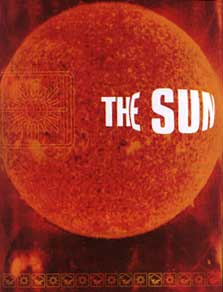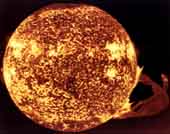
http://fusionanomaly.net/sun.html
The sun is a star, just like the other stars we see
at night. The difference is distance -- the other stars we see are light years
away, while our sun is only about eight light minutes away . Compared to other
stars our sun is just an "average" star, merely one of billions
of stars that orbit the center of our galaxy. It is a comprised of gas, mostly
hydrogen and helium. The suns size generates a gravitational force large enough
to hold all of hydrogen and helium together (and to hold all of the planets
in their orbits around the sun!).

http://www.solarviews.com/cap/sun/sun.htm
The Sun"s Core produces an enormous
energy output (3.86e33 ergs/second or 386 billion billion megawatts) by nuclear
fusion reactions. Every second about 700,000,000 tons of hydrogen are converted
to about 695,000,000 tons of helium and 5,000,000 tons (=3.86e33 ergs) of
energy in the form of gamma rays. While in the Radiation Zone gamma rays travel
out toward the surface, the energy is absorbed and re-emitted at lower and
lower temperatures. The convection Zone consists of convection currents which
carry photons outward to the Sun's surface faster than either radiative transfer
that occurs in the core or radiative zone.

http://science.howstuffworks.com/sun1.htm
In addition to heat and light, the Sun also emits a
low density stream of charged particles (mostly electrons and protons) known
as the solar wind which propagates throughout the solar system at about 450
km/sec. The solar wind and the much higher energy particles ejected by solar
flares can have dramatic effects on the Earth ranging from power line surges
to radio interference to the beautiful aurora.
Previous
....TitlePage.......Next
background
courtesy of www.bellsnwhistles.com


